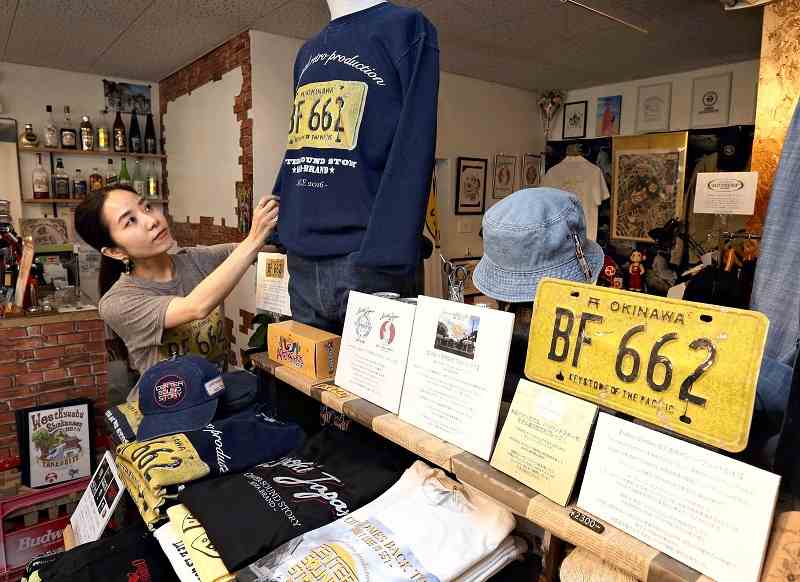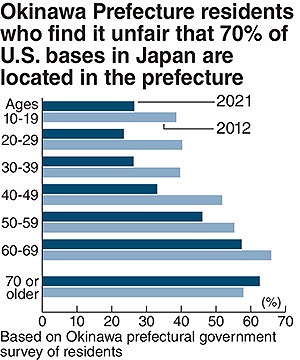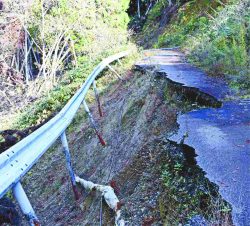
Maino Tamaki arranges merchandise that evokes life during the occupation years, such as cloth hats and a yellow license plate, at her shop in Okinawa, Okinawa Prefecture.
7:00 JST, April 17, 2022
Fifty years after Okinawa’s return to Japanese control, 70% of U.S. military facilities in Japan remain concentrated in the island prefecture. But local attitudes toward the presence of the bases appear to be changing.
The prefecture announced in March the results of a survey taken last year that showed the percentage of people under 40 who regarded the current situation as “unfair” was less than half that of those in their 60s or older.
This suggests a trend that the younger someone is, the more likely they are to accept the situation. People who grew up thinking it normal to see a base in their neighborhood are searching for ways to come to terms with the facilities.
History of Koza in clothing
The yellow license plate of U.S. military vehicles, an “A” sign that designated a bar as approved for U.S. forces — these are some of the items at an Okinawa City clothing shop, which is lined with apparel bearing designs reminiscent of the days under U.S. occupation.
“I wanted people to know about the history of Koza,” said the shop’s manager, Maino Tamaki, referring to the former name for Okinawa City.
The 39-year-old Tamaki, whose grandparents lived through the brutal Battle of Okinawa during World War II, had heard from neighbors about how the local people were treated disparagingly by the occupying forces.
She knew about the 1970 incident known as the Koza Riot, when a traffic accident caused by a U.S. military vehicle sparked an uprising in which local people set ablaze U.S. vehicles that had arrived on the scene, and that the yellow license plates were objects of anger.
Tamaki grasped that many people shared the sentiment of not being able to tolerate the bases.
But Tamaki grew up along the Koza Gate Street that fronted Kadena Air Base, and went in and out of the base as a child. Influenced by Western music, she became a dancer.
Six years ago, she opened the clothing store with her younger brother to add life to the area, which had become desolate. The shop is themed on the history of Koza and its relationship with the base.
She understands the pain felt by the generation that knows of that era, so she displays a description of the riot in the shop to let customers know what happened. “We are here because of this history,” she said.
“You can’t simply say you are ‘for’ or ‘against’ the base,” Tamaki said. “I’d like to hold in high regard the fact that we come down this path together. I want people to also know that there is the aspect that we have benefited as well.”
Unlinked human chain
Since 1979, Okinawa Prefecture has been conducting a survey on residents every three to five years to grasp what they value and how their needs are changing, with the information applied to prefectural administration.
Surveys from 2012 have added the question on whether people think it is an unfair situation that about 70% of U.S. military facilities are located in the prefecture. Last year, about 60% of people aged 60 or older responded “Yes,” while only about 25% of those under 40 agreed.

●●●●
Except for those in their 70s or older, the rate of people who agree with the sentiment is declining for each age group. The under-40 group showed a drastic drop from about 40% in 2012.
The same trend can be seen in another survey done in 2017 by a team led by Waseda University on about 500 people in the prefecture. The younger the respondent, the weaker was their opposition to the U.S. bases.
“Young people have no experience of the Battle of Okinawa or the U.S. occupation,” said Yukihiro Yoneda, an associate professor at Wako University who participated in the survey. “We see a trend in which they have an awareness of national security and keenly recognize the local economy’s dependence on the bases. The gap is widening between how the generations view the bases.”
Protests against the bases have been scaled down in accordance with the changes in how the young view the situation. It has been more than a decade since the Okinawa Heiwa Undou Center, a protest group formed by labor unions and other entities, has formed a human chain around a U.S. base.
In 2007, the center failed to gather enough protesters to make a human chain long enough to surround Kadena Base, and since then, it gradually abandoned the tactic.
“Even if public opinion against the bases is shown in elections, it gets ignored and makes some young people feel powerless,” said Takashi Kishimoto, 59, the center’s director.
The Okinawa district headquarters of the All Japan Garrison Forces Labor Union, formed by employees of U.S. bases, withdrew from the protest group in 2008. Behind that decision was the fact that the bases have become stable workplaces in the prefecture, and younger people tend to shy away from protest activities.
Beyond pros and cons
Film director Kazuhiro Taira, however, has changed how he feels about the bases in the opposite way. The 32-year-old Okinawa City native used Koza as the setting for his film titled “Miracle City Koza.”
Taira had studied at Okinawa International University, where a U.S. military helicopter crashed in 2004. Even so, “The bases were something I took for granted. I was indifferent,” Taira confessed.
But in making his film, his view changed after interviewing many people who went through the prefecture’s postwar tribulations. “The bases brought much more anger and sadness than joy,” Taira said. “I started feeling how dangerous it was to think that it was only natural to put up with their presence.”
Young people wishing to express dissent against the bases are seeking ways to do so. In 2019, the prefectural government held a referendum for residents to approve land reclamation for relocating the Futenma Air Base to the Henoko district in Nago.
Hitotsubashi University graduate school student Jinshiro Motoyama, 30, worked on realizing the referendum, joining protests in Henoko. But hearing the chanting of the same slogans over and over, he thought it would be impossible to attract more young people to the cause.
Looking for a way to help resolve base-related problems, Motoyama continues to organize forums to discuss the base issues beyond the pros and cons of certain aspects.
“It is a problem that our children and grandchildren will face, too,” Motoyama said. “I want Okinawa to be a place where young people can candidly exchange opinions about the bases.”
"Society" POPULAR ARTICLE
-

M4.9 Earthquake Hits Tokyo, Neighboring Prefectures
-

Israeli Tourists Refused Accommodation at Hotel in Japan’s Nagano Pref., Prompting Protest by Israeli Embassy and Probe by Prefecture
-

M7.5 Earthquake Hits Northern Japan; Tsunami Waves Observed in Hokkaido, Aomori and Iwate Prefectures
-

Tsukiji Market Urges Tourists to Avoid Visiting in Year-End
-

M5.7 Earthquake Hits Japan’s Kumamoto Pref., Measuring Upper 5 Intensity, No Tsunami Expected
JN ACCESS RANKING
-

Tokyo Economic Security Forum to Hold Inaugural Meeting Amid Tense Global Environment
-

Keidanren Chairman Yoshinobu Tsutsui Visits Kashiwazaki-Kariwa Nuclear Power Plant; Inspects New Emergency Safety System
-

Imports of Rare Earths from China Facing Delays, May Be Caused by Deterioration of Japan-China Relations
-

University of Tokyo Professor Discusses Japanese Economic Security in Interview Ahead of Forum
-

Japan Pulls out of Vietnam Nuclear Project, Complicating Hanoi’s Power Plans























